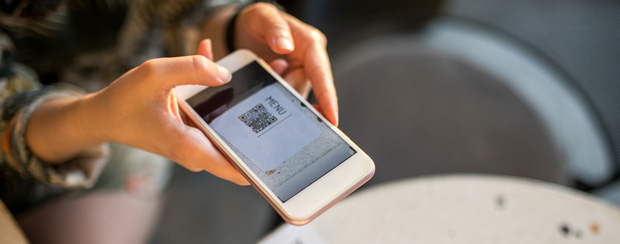Quick response (QR) codes—matrix-shaped barcodes that consumers can scan with their smartphones to get more information about whatever they’re looking at—have been around for more than a decade. But businesses have been slow to embrace them—until recently. During the pandemic, many businesses, including restaurants and retailers, started using QR codes for both their convenience and safety and their ability to create a more engaging and immersive customer experience.
“The customer journey has changed, and more small businesses are taking advantage of QR codes as a way to market in a mobile-first world,” says Kimberly Ring Allen, founder of Ring Communications, an integrated marketing firm in Boston. “Getting people’s attention is tough these days, and QR codes offer a way to do that.”
“The customer journey has changed, and more small businesses are taking advantage of QR codes as a way to market in a mobile-first world.”
How to use QR codes for your business
QR codes can be used for sales, marketing, supply chain logistics, payments and more. They can appear on a product, a package, a flyer, a billboard, a TV ad, the side of a truck—or in pretty much any physical space.
By scanning the code with their smartphone, a consumer has instant access to a business’ online presence. For example, a QR code on a real estate company’s “For Sale” sign might lead to the online listing, a virtual tour of the house or the company’s website.
Jon Stern, CEO of Ringpin, a San Diego-based company that creates digital experiences for companies, says QR codes can play a big role in that. “Every physical product and location is likely to have a digital experience attached to it someday,” he says. “And it will span across all sorts of industries, from retail to airlines to real estate to manufacturing.”
For example, Ringpin creates QR codes for businesses that allow consumers to access gift registries, redeem rewards and buy products. It added a QR code to a book cover that directs potential buyers to a video by the author, along with reviews. It also puts them on business cards, making it easy for someone to scan and schedule a meeting online with the person whose information is on the card. It also uses them in corporate gifting. A QR code can be put on, say, a box of cookies, leading to a video of the gift-giver delivering a message like “Welcome to the team” or “Thanks for being such a special customer.”
Here are a few other examples of how a business can use QR codes:
- Signing people up for its email newsletter
- Directing people to its online store, while offering a special discount
- Entering people into a raffle for a giveaway
- At restaurants, letting guests view the menu, order, pay, receive real-time promotions or learn more about the wine or cocktails on the menu—or all of the above
“It can be a real game-changer for high-volume restaurants especially,” says Bo Peabody, co-founder of Seated, a restaurant discovery app launched in 2019 that uses QR codes to create a direct digital relationship between restaurant owner and guest.
The benefits of QR codes
One big benefit of the QR code is ease of use. Consumers no longer have to type information, like a coupon code or a web address, into their phones. Access is instantaneous, and content can be saved to study later.
Another plus: There are many apps or websites that provide static QR codes for free, among them QR Code Generator, QRCode Monkey and Google Chrome. Dynamic codes that can be edited and updated involve a fee.
To set up a QR program for success, Stern recommends considering the size and placement of the code, making sure it’s in a highly visible, high-traffic spot. Also be clear about your “call to action.” As Stern notes: “Why are you telling people to scan, and what is the perceived benefit? What is the value for the customer?”
Cheryl Ritzel, owner of FocusEd Camera in Hoschton, Georgia, says QR codes have allowed her to enrich her offering in new ways. Her small business, which offers photography classes, uses them to guide students to additional educational resources and to products like her Ultimate Photography Cheat Sheet that she sells on Etsy.
“They’re interesting little inventions, convenient and versatile and easy to use,” she says. “I was using them well before COVID and will continue to use them after. They’re a nice little surprise for people.”
Print this article



0 Comments